
Original Link: https://www.anandtech.com/show/2190
MSI P6N SLI Platinum: NVIDIA's 650i Part Two
by Gary Key on March 13, 2007 1:00 AM EST- Posted in
- Motherboards
Since our first look at the 680i chipset back in November, we along with our readers have wondered when the lower priced 650i family of chipsets would arrive, and more importantly how they would perform. ASUS was first to market with the NVIDIA 650i SLI chipset in late December and we fully expected to see other manufacturers following in January. It is now March and we are just now starting to see boards based on this chipset finally coming to market. MSI has released two 650i based boards with the P6N SLI-FI competing in the $115 market space and the P6N SLI Platinum should be coming in around $155 or less once supply is available. ECS has their 650i board in the market now and we should see abit releasing 650i product into the retail channels by the end of the month. Unfortunately, Gigabyte's performance oriented 650i board will not arrive until sometime in April.
The base 650i Ultra boards were expected in February but are missing in action and at this time we wonder if they will even be released. Usually we find NVIDIA based products being hard launched upon announcement day but the 650i chipset has not followed that pattern. This chipset should be the bread and butter offering in the NVIDIA Intel chipset family as it was designed to compete against the Intel P965 in the mainstream market. In our original look at the chipset we found it offered very good performance and indeed in most ways was a competitive offering to the P965.
We really liked the chipset and looked forward to seeing it and the P965 square off against each other in a myriad of configurations and price points. Sadly, it appears these scenarios will not happen in the same way that we had envisioned it after the marketing hoopla that followed the 680i launch. The 650i SLI was designed to offer dual x8 SLI operation, provide competitive platform performance to the Intel P965, and do this for a price in the $115~$165 range. We still think it can, but with the Intel P35 launching shortly, it appears that the late arrival of these 650i products is only going to further hurt NVIDIA's progress in the Intel chipset market.
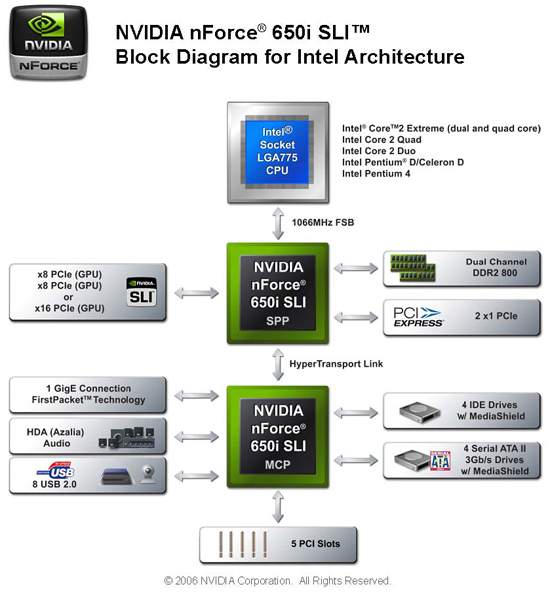
NVIDIA designed the 650i SLI as their true mainstream Intel performance chipset, with the 680i targeted at the upper end performance segment and priced around $220 compared to $115 for the 650i. Details about the differences between the two chipsets can be located here. The major highlights are the 650i only supports dual x8 SLI operation, single Gigabit Ethernet, four SATA 3Gb/s ports, eight USB 2.0 ports. The 680i in contrast supports dual x16 SLI, an additional x16 physics card slot, dual Gigabit Ethernet with teaming, six SATA 3Gb/s ports, and ten USB 2.0 ports on the 680i.
Although NVIDIA did not originally state specific support for the upcoming 1333FSB processors on the 650i, the board manufacturers are telling us their boards will be capable of full support with an updated BIOS release unless otherwise noted. We also noticed that ASUS included EPP memory capability along with LinkBoost technology on their 650i board. These items are not officially supported by NVIDIA in their product documentation but each feature did work as advertised; these features are not available on the ECS or MSI boards.
This leads us into today's performance preview of the MSI P6N SLI Platinum. In our article today we will briefly go over the board layout and features, provide a few important performance results, and discuss our findings with the board. We will provide a further in-depth review of this product in our upcoming 680i/650i roundup. With that said, let's take a quick look at this impressive 650i solution from MSI.
MSI P6N SLI Platinum Basic Features
| MSI P6N SLI Platinum Specifications | |
| Market Segment: | Mid-Range Performance - $165 |
| CPU Interface: | Socket T (Socket 775) |
| CPU Support: | LGA775-based Pentium 4, Celeron D, Pentium D, Pentium EE, Core 2 Duo, Core 2 Extreme |
| Chipset: | NVIDIA 650i SPP (C55) + 430i MCP (MCP51) |
| Bus Speeds: | Auto, 400 to 2000 (100~500) in 1MHz increments |
| Memory Ratios: | Auto, Sync |
| Memory Speed: | 400MHz~1400MHz in various increments |
| PCIe Speeds: | 100MHz~200MHz in 1MHz Increments |
| Core Voltage: | Auto, +0.125V to +0.3875V in 0.0125V increments |
| FSB Options: | Auto, Linked, Manual |
| CPU Clock Multiplier: | Auto, 6x-11x in 1X increments - Core 2 Duo, downwards unlocked, Core 2 Extreme 6x-16X |
| DRAM Voltage: | Auto, 1.80V to 2.80 in .05V increments |
| DRAM Timing Control: | Auto, Manual - 10 DRAM Timing Options |
| NB Voltage: | 1.25V to 1.50V in .05V increments |
| SB Voltage: | 1.50V, 1.60V, 1.65V, 1.70V |
| FSB VTT Voltage: | 0% to 20% Increase, various increments |
| Memory Slots: | Four 240-pin DDR2 DIMM Slots Dual-Channel Configuration Regular Unbuffered Memory to 8GB Total |
| Expansion Slots: | 2 - PCIe X16 (2-x8 electrical for SLI or Multi-GPU) 1 - PCIe x1 3 - PCI Slot 2.2 |
| Onboard SATA/RAID: | 4 SATA 3Gbps Ports - 430i MCP (RAID 0,1, 0+1, 5, JBOD) 1 e-SATA 3Gbps Ports - Silicon Image SiL3531 |
| Onboard IDE: | 2 ATA133/100/66 Port (4 drives) - 430i MCP |
| Onboard USB 2.0/IEEE-1394: | 8 USB 2.0 Ports - 4 I/O Panel - 4 via Headers 2 Firewire 400 Ports by VIA 6308P - 1 I/O Panel, 1 via Header |
| Onboard LAN: | NVIDIA Gigabit Ethernet - PCI Express - RTL8211BL PHY - 1 port via 430i MCP |
| Onboard Audio: | Realtek ALC888 - 8-channel HD audio codec |
| Power Connectors: | ATX 24-pin, 8-pin EATX 12V |
| I/O Panel: | 1 x PS/2 Keyboard 1 x PS/2 Mouse 1 x Parallel Port 1 x S/PDIF Optical - Out 1 x S/PDIF Coaxial - Out 1 x IEEE 1394a 1 x Audio Panel 2 x RJ45 4 x USB 2.0/1.1 |
| BIOS Revision: | AMI 1.1, VP.02, 1.22 |
| Auto Overclocking: | D.O.T. , Manual, 1%, 3%, 5%, 7%, 10% overclocking rates |
| Board Revision: | v1.0 |
MSI offers a moderate level of BIOS options available for tweaking the board, with significant emphasis placed on the available memory settings. We found in memory testing that switching to manual settings and changing the CAS, tRCD, tRP, and tRAS was required to ensure optimum performance as our performance results will show shortly. The FSB VTT voltage setting was a welcome addition during quad core overclocking but we did experience one quirk when initially setting up the board for overclocking. The user will have to press the F4 key in order to gain access to the C1E option in order to disable it. Why MSI hid this option and did not mention it in an otherwise top notch user's guide is beyond us, but it was easily changed after a visit to the MSI technical forums.
We tested the board with the release 1.1, beta VP.02, and the soon to be released 1.22 BIOS releases. Our test scores are based upon the 1.22 release. This release fully enables downward multipliers on the Core 2 Duo processor series, fantastic stock performance, and offers decent overclocking performance. We have not found any real show stoppers in this BIOS from a component compatibility, stability, or features viewpoint, although the BIOS still requires some performance tuning in the areas of overclocking and enabling memory speeds above 1067 in our experience. Our other complaint about the BIOS is the fact we typically have to run our voltages slightly higher than on other boards to match the same timings or overclock levels.
The board also features MSI's D.O.T. (Dynamic Overclocking Technology) overclocking system that will "intelligently" overclock the system based upon CPU load from predetermined settings that range from 1% to 10%. This system generally overclocked our setup without issue when using the five or seven percent settings. D.O.T. is designed for users who want a little extra performance without worrying about tuning multiple BIOS settings. Considering most people won't notice anything less than a 10% performance boost, the D.O.T. is of limited use for most users - though admittedly 5% saved on something like video encoding tasks might prove useful.
MSI P6N SLI Platinum Board Layout and Design
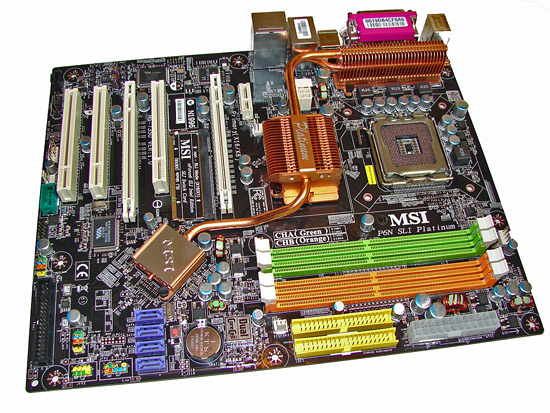 |
| Click to enlarge |
The board layout that MSI devised for this chipset is actually quite good and we are glad to see MSI utilized muted colors and a black PCB design. The board features an excellent four-phase power design and a significant use of Conductive Polymer Aluminum Solid Capacitors. There are four fan headers (one 4-pin and three 3-pin) located in easy to reach positions on the board that are controlled through MSI's Dual Core Suite or the BIOS. We did find the new PC Alert program only reported on the status of two fans during testing.
MSI continues their tradition of being different by color coding the memory slots in a way that will confuse other owners of Intel boards. The memory slots are not color coded correctly for dual channel operation. You will need to insert memory in a green and orange slot for dual channel operation.
The board easily installed into our Cooler Master CM Stacker 830 case and cable management was very good for the optical and hard drives. The floppy drive connector is located at the bottom of the board and could present an issue for larger cases where the enclosed cable is not able to reach the floppy drive. The area around the CPU is slightly cluttered but we had no issues fitting our larger air coolers on this board. However, installation of our Tuniq 120 and Scythe Infinity coolers was slightly difficult due to the location of the 8-pin ATX power connector.
The PCI Express and PCI slot arrangements are designed with multiple graphics card operation in mind but this layout will mean the loss of a PCI slot if dual slot video cards are utilized. This will still leave two PCI slots and a single PCI-E x1 slot available for use. Like all 650i boards to date, this one requires the use of a paddle card to enable dual video card use.
The C55 SPP is cooled by a large passive heatsink that worked fine up until we started overclocking above 425FSB range, as that required an increase in voltage to 1.45V. This required the use of the included chipset fan to properly cool the SPP when an aftermarket cooler is installed that does not cool the surrounding components in the CPU area. We highly suggest a case with good airflow for this reason and the fact that the nForce 430i MCP does not receive active cooling.
Speaking of the nF430i MCP, it features four SATA 3Gb/s ports and two UltraATA 133 IDE ports that support up to four drives. This board offers an excellent balance of SATA and PATA drive capability. MSI breaks with recent tradition and utilizes a Silicon Image Sil3531 chipset for e-SATA capability on the back panel instead of the JMicron chipset used in most Intel P965 boards.
The audio subsystem is based on the Realtek ALC888 and offers 8-channel output. Realtek has had troubles recently with EAX 2.0 support but we did notice a slight improvement in the 1.61 driver set with several games, though Battlefield 2 continues to present problems for Realtek. The ADI 1988B HD audio codec on the upper end ASUS boards or the Creative X-Fi chipset utilized on the new MSI 680i still offers significantly better EAX audio quality in games than the Realtek HD codecs. MSI includes the excellent VIA VT6308 IEEE 1394 controller along with the Realtek RTL8211BL PHY for Gigabit Ethernet capability.
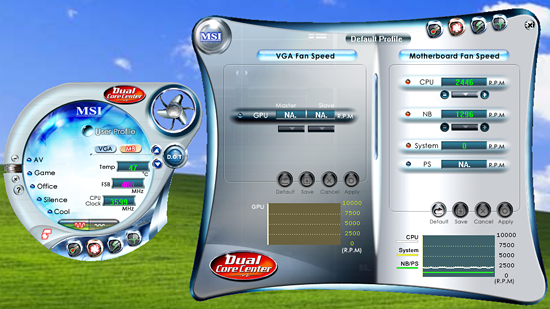 |
| Click to enlarge |
MSI includes their Dual Core utility which is a decent Windows based software applications for overclocking and hardware monitoring. Our primary issue with the application is that FSB overclocking is limited to 371 and not all voltages are available for manipulation. We feel like this application is best for those needing moderate overclocks with their boards during game play or audio/video encoding activities. Our initial testing under Vista also revealed a few minor graphical glitches and an occasional lock-up. These problems should be resolved in the next update. Speaking of Vista, users will need to download the latest drivers and utilities from MSI's website as the Installation CD does not contain them. Otherwise, the board has performed very well in our initial Vista testing routines and benchmarks.
Dual Core Overclocking
| MSI P6N SLI Platinum Dual Core Overclocking Testbed |
|
| Processor: | Intel Core 2 Duo E6600 Dual Core, 2.4GHz, 4MB Unified Cache 1066FSB, 9x Multiplier |
| CPU Voltage: | 1.4750V / 1.4000 (default 1.3250V) |
| Cooling: | Tuniq 120 Air Cooling |
| Power Supply: | OCZ ProXStream 1000W |
| Memory: | OCZ Flex XLC PC2-6400 (2x1GB) (ProMOS Memory Chips) |
| Video Cards: | 1 x MSI 8800GTX |
| Hard Drive: | Western Digital 150GB 10,000RPM SATA 16MB Buffer |
| Case: | Cooler Master CM Stacker 830 |
| Maximum CPU OC: | 425x9 (3-4-3-9 2T, 799MHz, 2.15V), CPU 1.4750V 3825MHz (+59%) |
| Maximum FSB OC: | 450x7 (3-4-3-9 2T, 799MHz, 2.15V), CPU 1.4000V 3150MHz (+69% FSB) |
| . | |
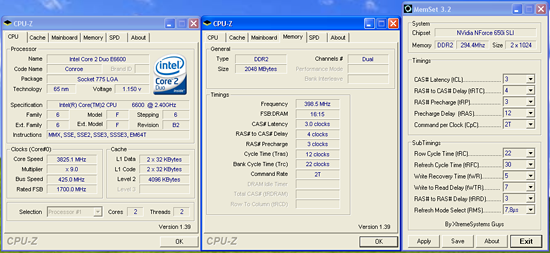 |
| Click to enlarge |
We were easily able to reach a final benchmark stable setting of 9x425 FSB resulting in a clock speed of 3825MHz. We were able to run our OCZ Flex PC2-9200 and our Corsair PC2-6400C3 at the reported timings with a 1T Command Rate enabled using the VP.02 beta BIOS. The 1.22 BIOS limited us to a 9x425FSB setting and DDR2-799 speeds at a 2T Command Rate, although we found performance in applications were actually better with this BIOS release. Vdroop was very acceptable on this board during overclocking with an average drop of .02 ~.03V during load testing with our E6300, E6600, and X6800 CPUs.
Testing with our new OCZ Flex PC2-6400 CAS3 (standard memory installed) and G.Skill F2-6400CL4D-2GBHK modules based on the ProMOS IC chips resulted in great success on this board. The OCZ Flex PC2-6400 was able to run at DDR2-799 (9x425) speed with timings at 3-4-3-9 2T at 2.15V and the G.Skill F2-6400CL4D at 4-3-3-8 2T at 2.15V. The remaining memory timings were set to Auto as the BIOS was very temperamental when manually setting the balance of timings available on the board. We did notice in 4GB testing that we had to change our OCZ Flex PC2-6400 CAS3 memory timings to 3-4-4-12 2T and increase voltage to 2.20V for stable 24/7 operation in a variety of applications.
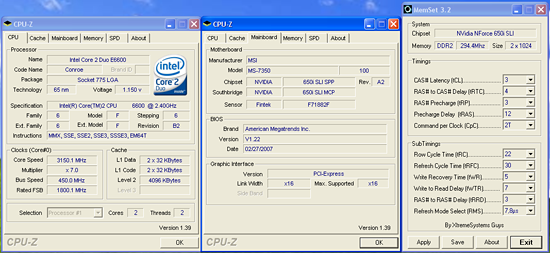 |
| Click to enlarge |
We dropped the multiplier on our E6600 to seven and were able to reach 450 FSB without an issue on the 1.22 BIOS. We were able to enter XP at 7x468 and the board would POST up to 7x503. However, at least with our sample, stability over 460 FSB dropped off quickly and we feel like this BIOS release was designed with ~465FSB in mind but not much more. The VP.02 BIOS proved to be stable at 485 FSB and would POST at 7x511 but memory timings had to be backed off to 5-6-5-12 at both the DDR2-800 unlinked or DDR2-1066 synced speeds.
Although we found overclocking performance to be better with the VP.02, memory performance was better on the 1.22 BIOS. The 1.22 BIOS also allows the use of downward multipliers on non-Extreme processors. The one drawback we noticed in testing was that memory speeds are limited to 1067 with this BIOS and Linked system settings resulted in the memory always staying at DDR2-800. MSI still has some fine tuning left to complete but overall the BIOS is in fairly good shape from both a performance and stability viewpoint. Once the board was dialed in, stability was absolutely superb.
Quad Core Overclocking
| MSI P6N SLI Platinum Quad Core Overclocking Testbed |
|
| Processor: | Intel Core 2 Extreme QX6700 Quad Core, 2.66GHz, 8MB Unified Cache 1066FSB, 9x Multiplier |
| CPU Voltage: | 1.4750V (default 1.3500V) |
| Cooling: | Tuniq 120 Air Cooling |
| Power Supply: | OCZ ProXStream 1000W |
| Memory: | OCZ Flex XLC PC2-6400 (2x1GB) (ProMOS Memory Chips) |
| Video Cards: | 1 x MSI 8800GTX |
| Hard Drive: | Western Digital 150GB 10,000RPM SATA 16MB Buffer |
| Case: | Cooler Master CM Stacker 830 |
| Maximum OC: | 365x10 (3-4-3-9 2T, 799MHz, 2.15V), CPU 1.4750V 3652MHz (+37%) |
| . | |
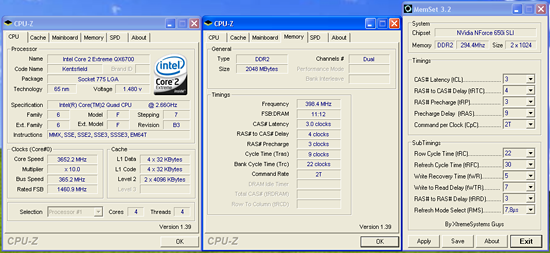 |
| Click to enlarge |
Needless to say, quad core overclocking on the 650i platforms has been an unknown due to the limited availability of boards. Our board reached a final 365FSB that we found to be extremely stable during testing and exceeded the 355FSB we have now reached on the ASUS 650i board. Even on the 680i boards, quad core overclocking has not been spectacular, and at times it's downright worrisome. The issues with the 680i boards are starting to change as both our ASUS and EVGA boards are capable of 400+ FSB quad core operation now. In the meantime, if you are looking for 425+ FSB overclocks with your quad core then certain Intel P965 or the AMD RD600 based boards are your best alternative.
We dropped the multiplier on our QX6700 and were unable to improve upon the same 365 FSB level at the stock 10x multiplier. The board would not even POST past 380FSB but we could enter XP at 373FSB although it was only good for a screenshot session. The one problem we noted was that we had to set our Northbridge, Southbridge, and FSB VTT voltages to their maximum settings along with raising our processor voltage to 1.4750V in order to maintain system stability. Our processor normally will run in the 3600MHz range at 1.4125V, and this was the highest voltage we have yet required on a board to reach this range.
Test Setup
| Standard Test Bed Performance Test Configuration |
|
| Processor: | Intel Core 2 Duo E6600 (2.4GHz, 4MB Unified Cache) Intel Core 2 Extreme QX6700 (2.66GHz, 8MB Unified Cache) |
| RAM: | OCZ Flex XLC (2x1GB), 2.30V (Micron Memory Chips) |
| Hard Drive: | Western Digital 150GB 10,000RPM SATA 16MB Buffer |
| System Platform Drivers: | Intel - 8.1.1.1010 NVIDIA - 9.35, 8.43 ATI - 6.10 |
| Video Cards: | 1 x MSI 8800GTX |
| Video Drivers: | NVIDIA 97.92 |
| CPU Cooling: | Tuniq 120 |
| Power Supply: | OCZ ProXStream 1000W |
| Optical Drive: | Plextor PX-760A |
| Case: | Cooler Master CM Stacker 830 |
| Motherboards: | ASUS Striker Extreme (NVIDIA 680i) - BIOS 1002 ASUS P5N-E SLI (NVIDIA 650i) - BIOS 0401 ABIT AB9 QuadGT (Intel P965) - BIOS 1.1 B06 DFI LANParty UT ICFX3200-T2R/G (AMD RD600) - BIOS 12/22 GIGABYTE GA-N680SLI-DQ6 - BIOS F3B/F3A Intel D975XBX2 (Intel 975X) - BIOS 2333 MSI P6N SLI Platinum (nForce 650i) - BIOS 1.22 / V.20 |
| Operating System: | Windows XP Professional SP2 |
| . | |
A 2GB memory configuration is standard in our XP test beds as most enthusiasts are currently purchasing this amount of memory - and we personally wouldn't think of running Vista with less than 2GB. Our choice of mid-range OCZ Flex XLC PC-6400 memory represents an excellent balance of price and performance that offered a very wide range of memory settings during our stock and overclocked test runs. We also utilized our Corsair XMS2 Dominator (Twin2x2048-9136C5D) memory on this board to verify DDR2-1066 compatibility with another memory type. We are currently completing testing several other memory modules ranging from Transcend, TwinMOS, and WINTEC DDR2-800 down to A-DATA DDR2-533 for compatibility and performance benchmarks, and we will provide more details on performance/compatibility with these memories in a future article. Our memory timings are set based upon determining the best memory bandwidth via MemTest 86 and test application results for each board. We only optimize the four main memory settings with sub-timings remaining at Auto settings.
We are utilizing an MSI 8800 GTX video card to ensure our 1280x1024 resolutions are not completely GPU bound for our motherboard test results. We did find in testing that applying a 4xAA/8xAF setting in most of today's latest games does not cause the performance of the system at our standard resolution to really change (i.e. we're CPU limited with the 8800 GTX). Our video tests are run at 1280x1024 resolution for this article at High Quality settings. We also tested at 1600x1200 and 1920x1200 4xAA/8xAF for our NVIDIA SLI results that will be presented in an upcoming 680/650i roundup.
All of our tests are run in an enclosed case with a dual optical/hard drive setup to reflect a moderately loaded system platform. Windows XP SP2 is fully updated and we load a clean drive image for each system to ensure driver conflicts are kept to a minimum. The MSI P6N SLI Platinum defaults to a 268FSB so we have to change our settings to manual and reduce the FSB to 266, and that also resulted in our DDR2 memory speed dropping to 799. As you will soon see, this did not have an adverse effect in our test results.
Synthetic Graphics Performance
The 3DMark series of benchmarks developed and provided by Futuremark are among the most widely used tools for benchmark reporting and comparisons. Although the benchmarks are very useful for providing apples-to-apples comparisons across a broad array of GPU and CPU configurations they are not a substitute for actual application and gaming benchmarks. In this sense we consider the 3DMark benchmarks to be purely synthetic in nature, but they are still very valuable for providing consistent measurements of performance.
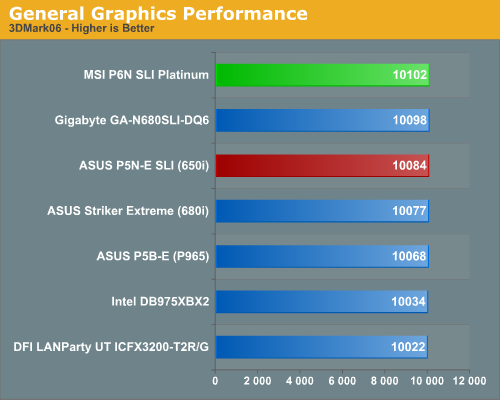
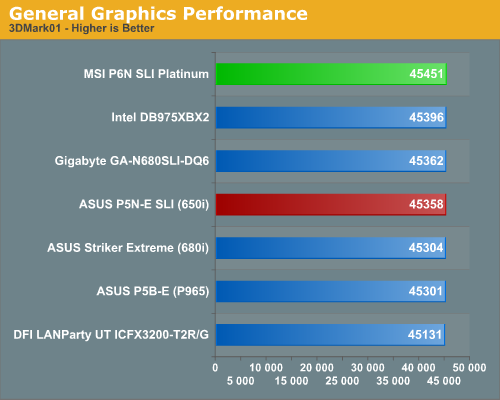
In our 3DMark06 test, each platform score is basically the same, though we see the DFI RD600 based motherboard trailing slightly. We attribute this to the slightly lower memory and video performance results in our latest BIOS release. Our MSI board tops the chart and offers the best CPU performance of our test boards in this benchmark.
In the more memory and CPU sensitive 3DMark01 benchmark we see our MSI 650i board topping the Intel 975X board, but the Sandra memory bandwidth results still greatly favor the 975x platform. Our Sandra memory bandwidth scores along with Memtest86 testing also consistently show the RD600 performing slightly better than the 680i or 650i, but our 3DMark01 benchmark does not show this advantage. Generally, NVIDIA based chipsets perform very well in graphics tests and the scores from our MSI P6N SLI Platinum indicate a highly tuned platform. We will see this pattern continue for the most part in our other tests.
Synthetic System Performance
The PCMark05 benchmark developed and provided by Futuremark was designed for determining overall system performance for the typical home computing user. This tool provides both system and component level benchmarking results utilizing subsets of real world applications or programs. This benchmark is useful for providing comparative results across a broad array of Graphics subsystems, CPU, Hard Disk, and Memory configurations along with multithreading results. In this sense we consider the PCMark benchmark to be both synthetic and real world in nature, and it again provides consistency in our benchmark results.
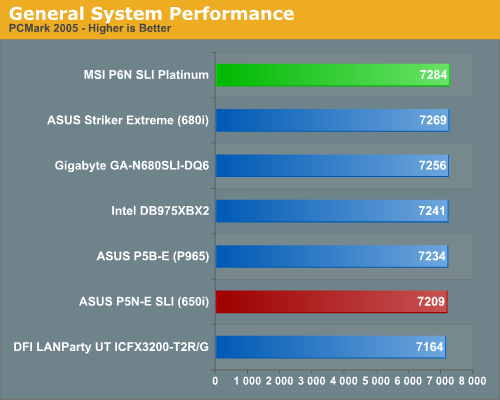
The MSI 650i board once again tops our charts is very competitive in this benchmark, although we expected slightly better results based upon our application results. The 650i and 680i chipsets scored very well on the single task disk benchmarks and both performed almost equally on the graphics subsystem tests where they led the field. However, our 975X and P965 chipset boards won the multitasking tests while the RD600 finished in the middle on most of the tests.
CPU Multitasking Results
We devised a script that would compress our standard test folder consisting of 444 files, ten subfolders, and 602MB worth of data, convert a 137MB High Definition QuickTime movie clip to a 37MB MPEG-4 format, play back the first two chapters of Office Space with PowerDVD, and run our AVG anti-virus program in the background. We stop the script when the file compression and video conversion are complete. This is a very taxing script for the CPU, Memory, and Storage subsystems. We also found our overclocking testing to be a good indicator of system stability.
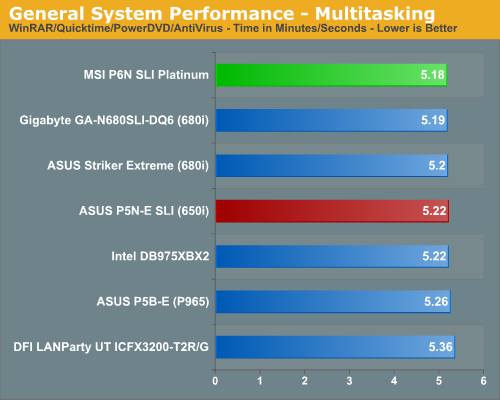
The performance difference basically mirrors our PCMark 2005 tests with the MSI boards finishing first due to great disk performance, though the Intel Chipsets consistently completed the QuickTime Conversion first - this is possibly due to the better memory bandwidth results Sandra showed. The DFI RD600 board scores last though it generated the best video playback results. We noticed it would stutter at times when converting the QuickTime file that led to its last place finish. The one surprise in this category is the ASUS P965 board as they generally do extremely well in multitasking scenarios under PCMark 2005. After reviewing the results we noticed the PowerDVD playback was not smooth and experienced several pauses. We are still looking into this and hopefully will have an answer soon.
Media Encoding Performance
Our first encoding test is quite easy - we take our original Office Space DVD and use AnyDVD Ripper to copy the full DVD to the hard drive without compression, thus providing an almost exact duplicate of the DVD. We then fire up Nero Recode 2, selected our Office Space copy on the hard drive, and perform a shrink operation to allow the entire movie along with extras to fit on a single 4.5GB DVD disc. We leave all options on their defaults except we check off the advanced analysis option. The scores reported include the full encoding process and are represented in minutes and seconds, with lower numbers indicating better performance.
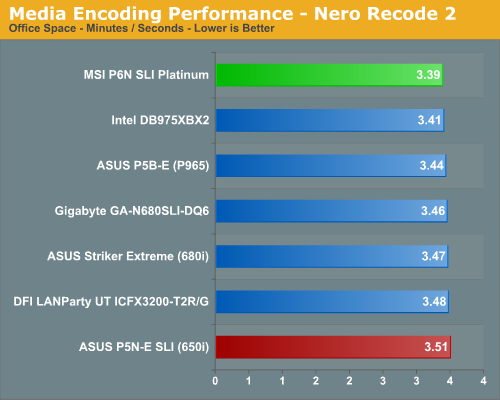
We continue to see a strong performance from the MSI 650i in our application tests. In previous testing our ASUS 650i and 680i boards were almost two minutes slower in this test as we consistently found the performance of the 680i/650i to be lacking due to disk access issues. The conversion process would consistently slow down while the disk was being accessed. The quality of the video conversion was never affected but it appeared under heavy CPU usage that disk performance suffered. After the latest round of BIOS and driver updates these two boards now score close to the other chipsets, with the MSI board now leading the Intel chipsets.
Audio Encoding Performance
While the media encoding prowess of the Intel chipset boards were superb in our initial media encoding testing, we wanted to see how they faired on the audio side. Our audio test suite consists of Exact Audio Copy v095.b4 and LAME 3.98a3. We utilize the INXS Greatest Hits CD that contains 16 tracks totaling 606MB of one time '80s hits.
We set up EAC for variable bit rate encoding, burst mode for extraction, use external program for compression, and to start the external compressor upon extraction. (EAC will read the next track while LAME is working on the previous track, thus removing a potential bottleneck with the optical drive.) We also set the number of active threads to two to ensure both cores are active during testing. The results are presented in minutes/seconds for the encoding process, with lower numbers being better.
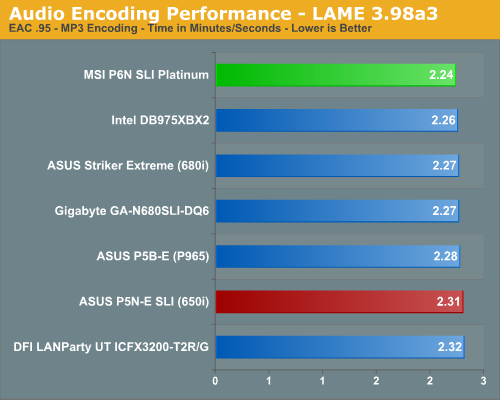
Our Plextor drive consistently took two minutes and nine seconds to read all sixteen tracks. This means our test systems are only utilizing one core during testing until the midway point of the extraction process where the drive speed exceeds the capability of the encoder and requires the use of a second thread.
As in the media encoding section, the more intensive CPU and storage system tests seem to favor the 975X over the P965/NV650i-680i/RD600 when running at the same memory timings. But once again the MSI P6N SLI Platinum board proves to be an exception to this rule at stock speeds. We ran the test several times and at one point the MSI board posted a 2 minute and 16 second result when we changed our command rate from 2T to 1T. We actually witnessed several test results where 1T performed exceptionally well but we could not get the board dual Prime95 stable with the 1.22 BIOS and 1T settings.
File Compression Performance
In order to save space on our hard drives and ensure we had another CPU crunching utility, we will be reporting our file compression results with the latest version of WinRAR that fully supports multi-threaded operations and should be of particular interest for those users with dual core or multi-processor systems. Our series of file compression tests utilizes WinRAR 3.62 to compress our test folder that contains 444 files, ten subfolders, and 602MB worth of data. All default settings are utilized in WinRAR along with our hard drive being defragmented before each test.
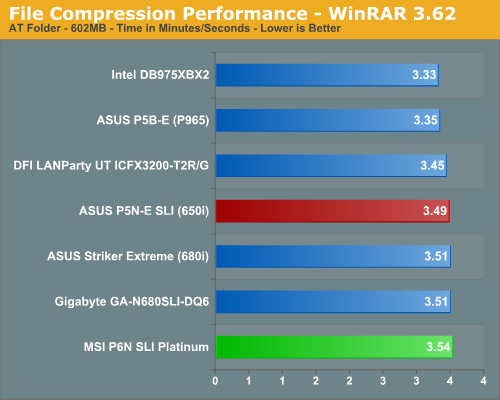
In a complete reversal of the other application results we see our MSI 650i board finishing last. We see the Intel P965 and 975X chipsets leading once again as both seem to thrive in this CPU intensive task. The DFI RD600 board finishes in the middle of the pack. Historically, the NV Intel chipsets have not done well in this test although they have exceptional disk performance results in our other tests. Changing our memory timings did not really affect the results and we had to increase our FSB to 272 before the NV boards scored the same as the Intel chipsets. When it comes to pure CPU crunching power, the Intel chipsets win hands down.
Standard Gaming Performance
As usual, gaming performance was tested with a variety of current games. We ran benchmarks with our standard 1280x1024 resolution without antialiasing enabled (and generally without anisotropic filtering, though that varies by game). Given the number of users that run 19" LCDs these days, 1280x1024 represents one of the most commonly used resolutions. We could certainly increase the amount of eye candy being displayed in most of the games, but as this is a motherboard benchmark we aren't particularly interested in maxing out the graphics cards in our tests.
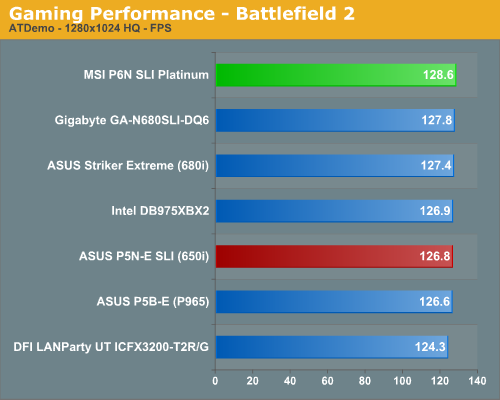
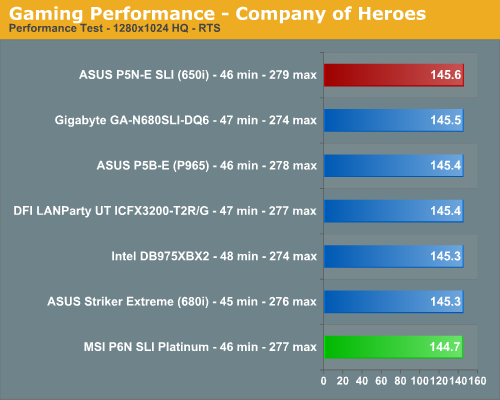
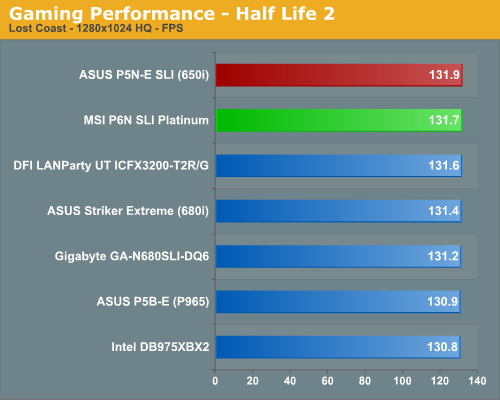
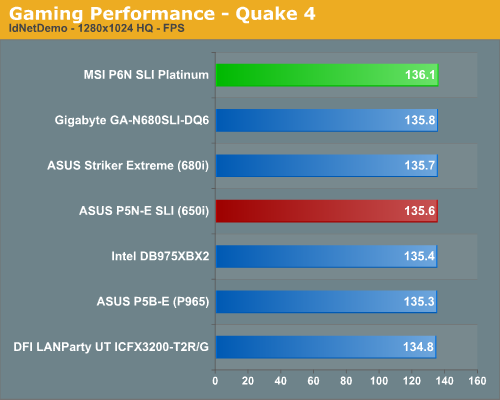
It's the same old song and dance but these results basically show that any of the chipsets listed will perform equally in today's games when equipped with the same high-end GPU. Our MSI board wins two benchmarks, finishes a very close second in one, and in the CPU intensive Company of Heroes finishes last - though it is less than a 1 frame per second difference from the top scoring ASUS 650i board. We did not experience any issues during testing or during game play with the MSI board. We generally play over a dozen different games for at least a couple of hours on each board to verify that there are no issues such as overheating, stuttering, or network connectivity problems when playing on-line with a various combination of components.
We will have a full selection of SLI game results along with a couple of new benchmarks in our 680i/650i review. In the meantime, we did not find any noticeable differences in 8800GTX SLI performance between the 680i and 650i chipsets up to 1920x1200 resolution in games. The synthetic benchmarks did show differences up to 6% but for the majority of gamers the differences in SLI performance between the two chipsets is negligible in actual game tests. It is only when you crank up the resolution to 2560x1600 or increase AA/AF settings that the dual x16 PCI Express capability on the 680i performs better than the dual x8 PCI Express setup on 650i, and even then the difference isn't all that great.
Disk Controller Performance
The AnandTech iPeak test is designed to measure "pure" hard disk controller performance, and in this case, we keep the hard drive as consistent as possible while varying the hard drive controller. The idea is to measure the performance of each hard drive controller with the same hard drive.
We played back our raw files that are recorded I/O operations when running a real world benchmark - the entire Winstone 2004 suite. Intel's iPeak utility was then used to play back the trace file of all I/O operations that took place during a single run of Business Winstone 2004 and MCC Winstone 2004. The drive is formatted before each test run and a composite average of three tests on each controller interface is tabulated in order to ensure consistency in the benchmark.
iPeak gives a mean service time in milliseconds; in other words, the average time that each drive took to fulfill each I/O operation. In order to make the data more understandable, we report the scores as an average number of I/O operations per second so that higher scores translate into better performance. This number is meaningless as far as hard disk performance is concerned, as it is just the number of I/O operations completed in a second. However, the scores are useful for comparing "pure" performance of the storage controllers in this case.
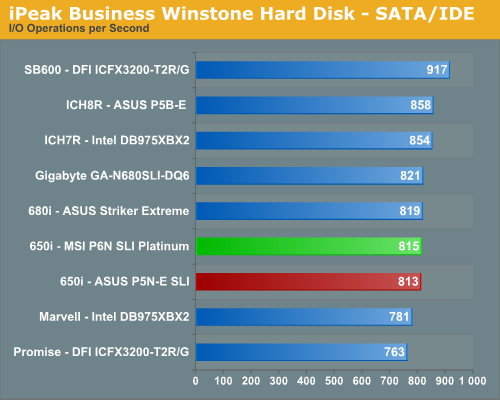
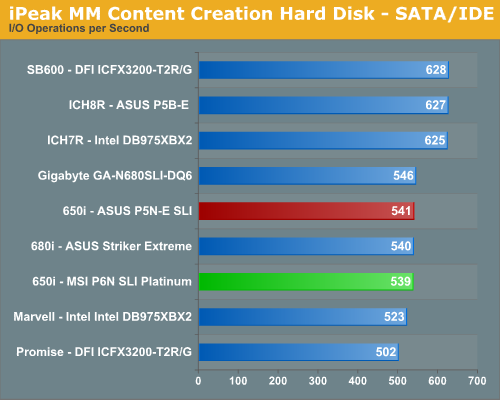
The performance patterns hold steady across both Multimedia Content I/O and Business I/O with the SB600 outperforming the Intel ICH7R, Intel ICH8R, and NVIDIA 680i/650i chipsets in our non-Raid tests. The Promise controller on the DFI board is the slowest of all solutions with the Marvell controller on the Intel 975X performing only slightly better. The 680i and 650i MCP chipsets are different but their disk performance in our tests is basically alike. We also ran RAID 0 and RAID 5 tests on each controller with the results being in favor of the 680i MCP by around 2%.
We did not witness any data corruption on our NVIDIA based boards as has been reported on the 680i reference boards, and we consider this problem to be fixed since our P23 BIOS update. We did have data corruption issues with the Gigabyte board when using 1T Command Rate at DDR2-800 with an early F2 beta BIOS but this was solved in the final F3 BIOS. Although our NVIDIA boards generally score lower in these "pure" throughput tests, we find their performance in disk intensive applications is generally better than the other solutions.
Power Consumption
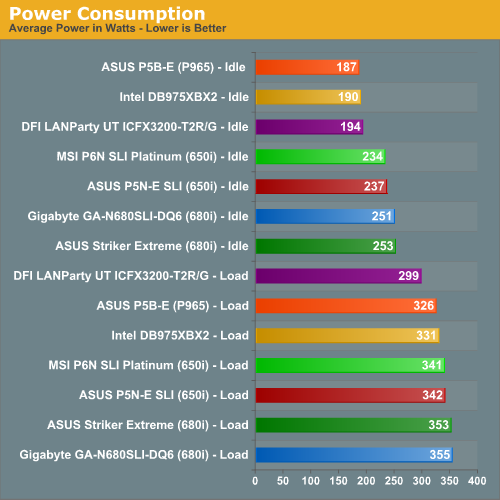
Our power consumption numbers are based on our test setup for this article that consists of the MSI 8800GTX video card, and our boards have C1E/EIST turned off. The 680i leads all boards in power consumption and the 650i SLI is second though on average it still consumes about 7% less power than the 680i at idle and 3% at load. The P965 consumes the least amount of power at idle but around 10% more than the RD600 at load. The 975X still offers a decent level of power conservation compared to the other chipsets even though it is over two years old now.
Overclocking
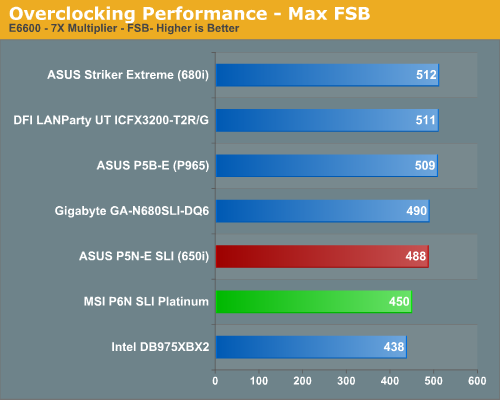
As we mentioned earlier in the article, the overclocking capability of the MSI board has varied widely with each BIOS release we have tested. This will be disappointing to some users and we expected a little better overclocking capability based upon the quality of the board and its BIOS options. However, like most recent MSI boards we find they have generally implemented very aggressive memory and chipset timings at stock speeds at the expense of overclocking. This is generally true of the MSI P6N SLI Platinum but we have found it overclocks better than most of the MSI boards we have tested recently.
One area we found interesting is the MSI board experienced several FSB holes with the 1.22 BIOS that we witnessed on the 680i reference boards. We did experience the typical FSB hole around 416FSB and hit another one right around 460FSB and 500FSB in the latest BIOS. We also found that during overclocking we had to set our CPU voltages a little higher than on the other boards to attain the same overclocks. We have experienced this before with other MSI boards and it was due to tighter sub-timings in order to improve the performance of the board at stock speeds.
First Impressions
In our first look at the 650i chipset we asked the $64,000 question: did NVIDIA succeed in designing a competitive chipset when compared to the Intel P965? Our answer to that question was a very reserved yes, the reason being that we did not know if the chipset or ASUS' implementation of it indicated the actual strength of the 650i. We had some hunches and believed the chipset was indeed competitive, but it certainly was not going to deliver a knockout blow to the P965. After working with the P6N SLI Platinum board for a couple of weeks and seeing MSI's dedication to improving performance and resolving issues with the 650i chipset we feel that $64,000 question can be answered now. Before we do, let's go over this board once again.
The performance of the board is excellent, and in some ways beyond excellent. The stock performance is impressive across a wide array of applications and games but considering the time it took to get to market we did expect slightly better overclocking performance and a fully polished BIOS. MSI is close and we fully expect them to improve upon the overclocking while addressing a few other niggling issues but we have to wonder at what price? Typically, you have to sacrifice overclocking for superb stock or near stock performance or you have to sacrifice a few performance points at the base level in order to ensure the board will properly reach its limits at the top. MSI recently has offered excellent stock performance and stability while trading off the overclocking capability at the mid to upper end of the chipset's capability. How they will ultimately balance the capabilities of this board will be interesting but for now they are leaning to excellent stock performance while offering a decent level of overclocking. This is not necessarily a bad balance in our estimation but ultimately the market will decide which option is best.
Finding a balance in this performance oriented market is always difficult. One group wants superb overclocking and multitudes of BIOS options at the expense of stock performance as they will tune in the performance based upon their needs. Another group will want excellent stock results with the ability to overclock to a level that allows them to extend the life of their components or to at least experience a level of performance near those spending hundreds of dollars more for a system. Of course, you also have the group that wants both and at times we hover in all three camps, but usually we want to have our cake and eat it too.
In the end, we feel like the positioning of this board as a Platinum design with an emphasis on performance and features means the target audience for this board will probably want to give up a little stock performance in exchange for slightly better overclocking. This board has at least reached the 450FSB level but we would like to see a little more headroom and have it balance out around the 485~500FSB range. We already know the board can do 515+ FSB with an E6300 and a special performance BIOS so the design is capable of it; finding that right balance is now in MSI's hands.
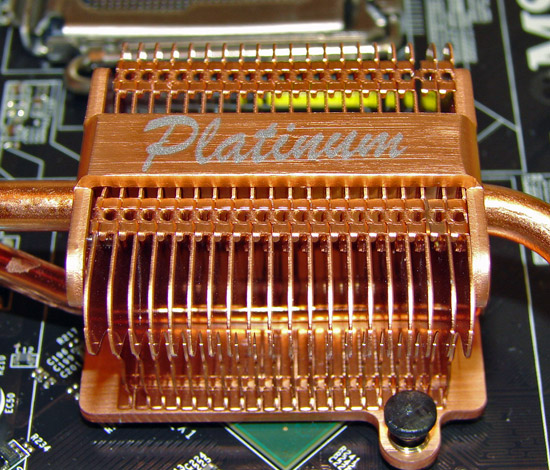
Back to that $64,000 question, we feel like in the majority of areas that the NVIDIA 650i chipset can compete directly with the Intel P965. This chipset will struggle against the P965 in pure overclocking capability, power consumption, memory performance, CPU crunching activities, and of course general availability. We found the 650i SLI offered similar if not better performance in most cases and excelled in gaming where its main purpose in life exists. The advantages the 650i SLI offers is official SLI support, native IDE chipset capability along with support for four IDE devices, very flexible memory and FSB settings, and a similar price to performance ratio when compared to the P965.
With all that said, based upon the performance results and feature set of the P6N SLI Platinum board it leaves us wondering why we would spend over $70 more for the 680i boards. Sure, the 680i boards have additional features such as dual Gigabit Ethernet connections with DualNet technology, dual x16 graphics slots along with a slot designed for physics capability, an additional two SATA 3Gb/s and USB 2.0 ports, and enhancements like LinkBoost, SLI Ready Memory, and extended overclocking and memory capabilities. However, does every user need these additional features or will they even use them?
For the vast majority of users we think not, and believe the 650i SLI chipset offers basically the same performance as the 680i about 98% of the time for significantly less money. It may turn out that this chipset doesn't deliver a knockout blow to the P965 but instead to the 680i in most cases. In the end, none of this much matters unless the motherboard based upon a 650i chipset lives up to its expectations.
We believe that the MSI P6N SLI Platinum lives up to and at times exceeds our expectations of an Intel based motherboard in this price category. We also think this motherboard restores faith in the MSI Platinum brand name that seeks to offer the best balance of price and performance for the user. MSI still has some balancing to do with this board and if they do it right, then it will deserve a lot more than just our recommendation. For anyone short of the extreme overclockers and tweakers, the board already offers everything you could want.







